Great Danish Designers 101: Ib Kofod-Larsen
Although born and educated in Denmark, furniture designer Ib Kofod-Larsen didn’t achieve as much renown there as his contemporaries, in part because he worked with manufacturers based outside of his home country. He realized his first success as a designer at home, but the recognition he received there led him abroad, to England and Sweden, where he was asked to “breathe new life” into the designs of two furniture makers whose pieces had become tired and dated. (Brdr. Petersens) Today there is an increasing appreciation for Kofod-Larsen’s designs, with corresponding jumps in demand and price.
Ib Kofod-Larsen: Honouring the Innate Qualities of His Chosen Materials
Ib Kofod-Larsen was born in Denmark in 1921. Like many of his contemporaries, he studied at the Danish Royal Academy in Copenhagen. His first recognition as a designer would come in 1948, when he won the Holmegaard Glass Competition. In that same year, he was rewarded for work in another medium, receiving the Danish Cabinetmakers Guild’s annual award. (Pamono.ca) Danish furniture maker Faarup Møbelfabrik saw his potential and hired him. It was here that he designed one of his more spectacular pieces: the Model 66 sideboard, shown below.
Image from MCMDaily.com.
His work with Faarup established him as a designer. He followed the basic tenets of Danish mid-century design, creating versatile, practical pieces with a graceful, minimalist aesthetic. Yet, in the minds of some collectors today, he stands out from other Danish designers of the mid-century period because of his “talent for honouring the innate qualities of his chosen materials.” (Pamono.ca) Kofod-Larsen was known for working with the natural grains and patterns in the raw materials he used and making those elements the focus of his designs. One of the finest examples of this tendency is a rosewood sideboard he designed for Faarup:
Images from 1stdibs.
In this sideboard, Kofod-Larsen created symmetry from the natural grain of the wood, highlighting an X-shaped pattern in the centre of the piece. In a testament to how much his designs are valued today, the asking price for this particular sideboard is nearly $14,000.00.
His work with Faarup brought Kofod-Larsen to the attention of furniture makers in Sweden and the UK. In Sweden, he worked with OPE Möbler to create one of his most famous designs, the Salen or Seal chair which was first made in the 1950s. The now iconic chair epitomized the human-centred design that was prevalent in the mid-century period. Comfort is the main focus, seen in the angled frame and arms that invite reclining, and the warm leather seating. Despite being made of heavy materials, there is still a lightness in the chair’s appearance, seen in the way the “leather shell seems to be floating inside the wooden frame.” (1stdibs)
A similar design for OPE Möbler received considerable attention from a very influential individual. Initially known as the U-56, this armchair was reportedly renamed after Queen Elizabeth II purchased a pair in 1958. Now more commonly known as the Elizabeth, the chair’s rosewood and leather version is among the most rare and valuable to collectors of Kofod-Larsen’s work. (JustCollecting) The chair shown below has an asking price in excess of $40,000.00.
Image from 1stdibs.
The Elizabeth was also designed as a settee, an especially rare piece, shown below.
Image from MCMDaily.
We’ve been fortunate enough to have several of Kofod-Larsen’s armchairs at VHB, including the two below—one in teak and the other in walnut. Both sold very quickly, a sign that his designs still resonate with homeowners today.
Among the seating Kofod-Larsen created, the “Penguin” chair was also very popular and remains one of his most well-known designs. The first incarnations were made in Denmark of solid wood. Later, the Selig company in the US would import the wooden components from Denmark and place them on a made-in-America metal base, as shown below. (Remodelista)
Image from 1stdibs.
As with his Seal and Elizabeth chairs, the focus of the Penguin chair was the person sitting in it. The curved back and angled seat cradled the body, offering a surprising amount of comfort in such a simple design. The solid wood version is shown here:
Image from Pamono.ca.
In 1962, Kofod-Larsen began working with British furniture manufacturer High Wycombe. The company had noticed a loss in market share as Scandinavian modern designs became more popular, and partnered with Kofod-Larsen to create the G-Plan line. (MCMDaily) The line included desks, sideboards, armchairs, sofas, and even room dividers, like this piece in our current collection.
His G-Plan designs proved very popular then and still sell well today on the vintage market. The desk and sideboard below show more of the range and style of the line. As with his initial designs for Faarup, you can see how he uses the wood grain to create a sense of symmetry, evident in the desk’s drawers and in the three doors of the sideboard.
Image from MCMDaily.
Image from 1stdibs.
The G-Plan line also included furniture for the dining room, like this set from our past collection. The chairs and table are made of African teak:
We also have in-stock another Kofod-Larsen teak dining table. The close-up of the leg joint shows the incredible craftsmanship he was known for, as the leg blends virtually seamlessly to the table top.
Ib Kofod-Larsen passed away in 2003, but his designs live on, both as vintage collectibles and reproductions. His Penguin chair has inspired many knockoffs, but Danish company Brdr. Petersens has recently announced that it will produce a “sanctioned” Kofod-Larsen reissue, or a “Penguin for purists.” The company, run by twin brothers Egon and Elring Petersen, specializes in making Danish modern upholstered seating and has also re-launched Kofod-Larsen’s famous Seal chair, proving that good design never goes out of style.




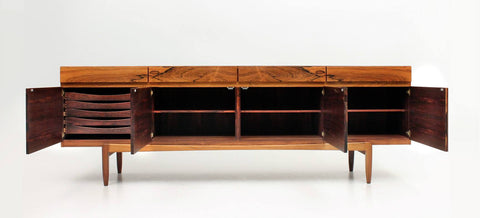
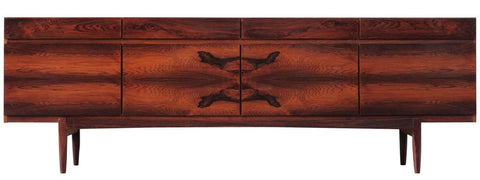

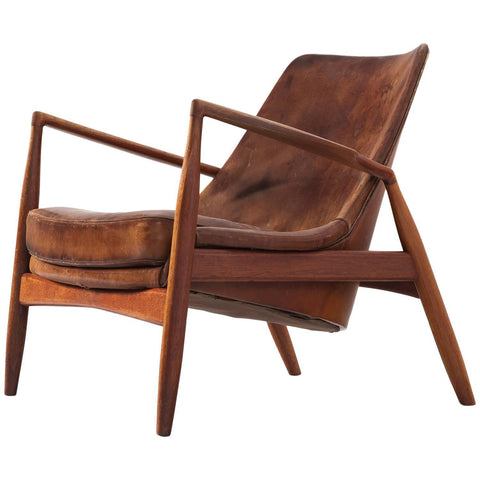
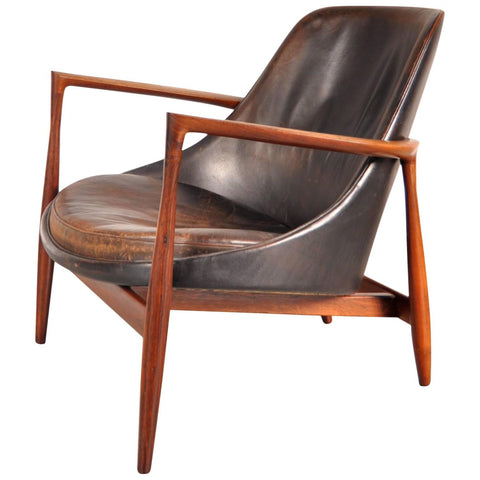

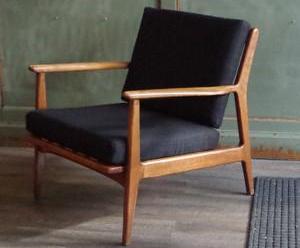

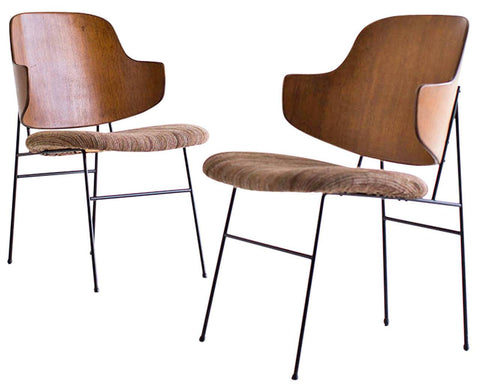


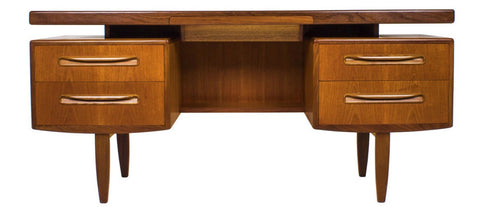

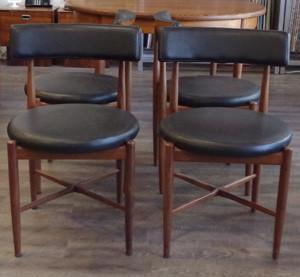
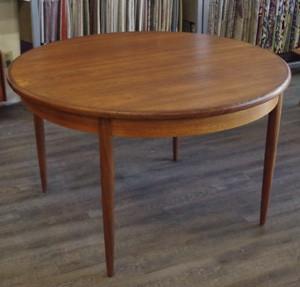


Leave a comment